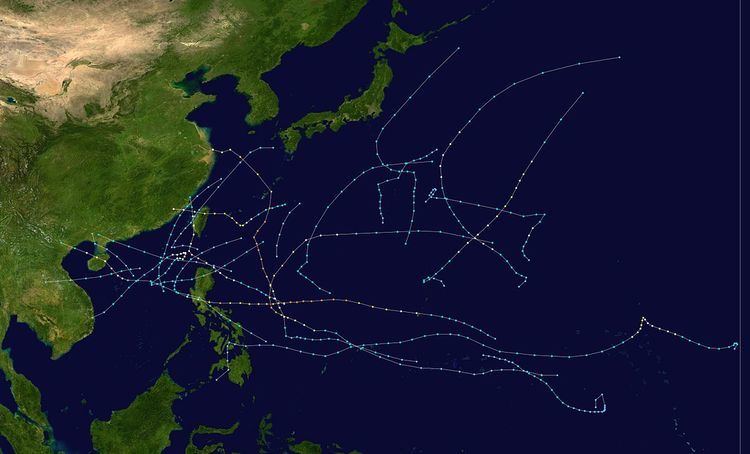First system formed January 10, 1977 Total storms 20 | Last system dissipated January 3, 1978 Total depressions 26 Typhoons 11 | |
 | ||
The 1977 Pacific typhoon season was one of the least active Pacific typhoon seasons on record, with only 19 tropical storms forming. It was also the second of the known typhoon seasons during the satellite era (since 1960) to not produce a Category 5 equivalent super typhoon.(After the 1974 season.) The season's first storm, Severe Tropical Storm Patsy, formed on March 23 and the last, Typhoon Mary, dissipated on January 2, 1978. With Mary spanning two calendar years, it became the fourth typhoon to do so since 1945. Since then, two other typhoons have achieved this feat.
Contents
- Systems
- Typhoon Thelma Goring
- Typhoon Vera Huling
- Super Typhoon Babe Miling
- Typhoon Dinah Openg
- Severe Tropical Storm Freda Pining
- Typhoon Kim Unding
- 1977 storm names
- References
The scope of this article is limited to the Pacific Ocean, north of the equator and west of the international date line. Storms that form east of the date line and north of the equator are called hurricanes; see 1977 Pacific hurricane season. Tropical Storms formed in the entire west pacific basin were assigned a name by the Joint Typhoon Warning Center. Tropical depressions in this basin have the "W" suffix added to their number. Tropical depressions that enter or form in the Philippine area of responsibility are assigned a name by the Philippine Atmospheric, Geophysical and Astronomical Services Administration or PAGASA. This can often result in the same storm having two names.
Systems
A total of 26 tropical depressions were recognized by the various warning agencies this year in the Western Pacific, of which 20 became tropical storms. Eleven storms reached typhoon intensity, of which one reached super typhoon strength.
Typhoon Thelma (Goring)
A tropical disturbance east of the Philippines organized into a tropical depression on July 21. It moved to the northwest, strengthening into a tropical storm later that day and into a typhoon on the 22nd. After passing northern Luzon and dropping heavy rains, Thelma turned to the north, where it reached a peak intensity of 95 mph winds. The typhoon hit southern Taiwan on the 25th, crossed the island, and dissipated over southeastern China on the 26th. Though not a particularly strong storm, Thelma brought strong wind gusts and heavy rain, claiming more than 30 lives and bringing damage and destruction not seen to the island for over 80 years.
Typhoon Vera (Huling)
Just 6 days after Thelma hit Taiwan, another typhoon was brewing to its east. Typhoon Vera, which developed on July 28, hit eastern Taiwan on the 31st as a 130 mph typhoon. It continued westward, and dissipated over southeastern China. The storm caused 25 additional fatalities to the island, with vast amounts of crop and property damage occurring.
Super Typhoon Babe (Miling)
Developing as a tropical depression on September 2, Babe initially tracked west-northwestward as it intensified. On September 5, an abrupt shift in steering currents caused the system to turn north-northwestward. Over the following two days, Babe quickly intensified, ultimately attaining its peak intensity early on September 8 with winds of 240 km/h (150 mph) and a barometric pressure of 905 mbar (hPa; 26.72 inHg). Not long after reaching this strength, another shift in the steering patterns caused the typhoon to execute a prolonged counter-clockwise arc, causing it to track through the Ryukyu Islands, as it interacted with a low pressure originating from the Korean Peninsula. During this time, the system gradually weakened and eventually it made landfall near Shanghai, China on September 11 as a minimal typhoon before dissipating inland the following day.
Passing through the Ryukyu Islands as a powerful typhoon, Babe caused considerable damage in the region. More than 1,000 homes were destroyed and nearly 7,000 more were damaged or flooded. One person was killed on Amami Ōshima and 77 others were injured throughout the country. Total losses reached ¥6.1 billion (US$23 million). Offshore, over 100 vessels were affected by the storm, including a Panamanian freighter where 13 people lost their lives. In China, more than 24,000 homes were destroyed and nine people were killed.
Typhoon Dinah (Openg)
The monsoon trough spawned a tropical storm on September 14 northeast of the northern Philippines. The previous typhoon brought the trough more northward, hence the unusually high latitude for a monsoon storm. Strong high pressure to Dinah's northwest forced the storm to the southwest, where it crossed northern Luzon on the 15th and 16th. Weak steering currents in the South China Sea allowed Dinah to drift, first then to the northeast then back to the west-southwest. Generally favorable conditions allowed Dinah to reach typhoon strength on the 19th, but a developing tropical storm to its northeast caused it to weaken. The building of the subtropical ridge forced Dinah to the southwest, where it hit southern Vietnam on the 23rd as a tropical depression. The remnants turned northward, crossed the Gulf of Tonkin, and dissipated over China on the 27th.
Dinah brought heavy rain and flooding to Luzon that killed 54 people and left 11 others missing.
Severe Tropical Storm Freda (Pining)
Tropical Storm Freda struck Hong Kong killing one person.
Typhoon Kim (Unding)
Typhoon Kim was a 145 mph typhoon that hit the northern Philippines on November 13. The typhoon's heavy rains caused flash flooding that left 55 people dead with widespread damage. A further 47 people died when an upper floors of a hotel caught fire during the storm.
1977 storm names
Western North Pacific tropical cyclones were named by the Joint Typhoon Warning Center. The first storm of 1977 was named Patsy and the final one was named Mary.
